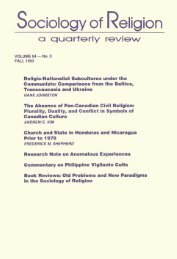The Sources of Gender Role Attitudes among Christian and Muslim ...
The Sources of Gender Role Attitudes among Christian and Muslim ...
The Sources of Gender Role Attitudes among Christian and Muslim ...
You also want an ePaper? Increase the reach of your titles
YUMPU automatically turns print PDFs into web optimized ePapers that Google loves.
218 SOCIOLOGY OF RELIGION<br />
TABLE 3<br />
OLS Coefficients for the Estimated Effects <strong>of</strong> Ethnicity <strong>and</strong> Religiosity on<br />
<strong>Muslim</strong> <strong>and</strong> Christim: Women's <strong>Gender</strong> <strong>Role</strong> <strong>Attitudes</strong> (n =, 468)<br />
<strong>Gender</strong> Traditionalism Index<br />
<strong>Muslim</strong> Ch¡<br />
b Beta b Beta<br />
Ethnidt~:<br />
Duration <strong>of</strong> U.S. residence<br />
Native-bom . . . .<br />
Less than 15 years 2.026** .180 3.525** .204<br />
15 years <strong>of</strong> more 1.689"* .243 .968** .147<br />
Amb spouse 1.154" .161 .483+ .076<br />
Arab ethnic organizations .741+ .109 .788* .115<br />
Relig~osity:<br />
Belief in scriptural inerrancy 1.432** .166 1.890"* .302<br />
High attendance .963+ .119 .287 .039<br />
Religiosity over the life cycle<br />
Low in childhood <strong>and</strong> adulthood . . . .<br />
Decreased since childhood 1.441 .122 .367 .034<br />
Increased since chiidhood 2.080* .216 ,270 .023<br />
High in childhood <strong>and</strong> adulthood 1.855"* .260 ,822+ ,111<br />
Bac~ f~:<br />
CoUege education -.441+ -.062 -.645+ -.103<br />
Children present in home -.391 -.056 .281 .034<br />
Age -.050 .035 -.041 -. 139<br />
Age 2 .001 + .024 .001 + .380<br />
Constant 5.965 7.834<br />
R 2 .253 .366<br />
Adjusted R 2 .201 .333<br />
+ p " < .I0, * p = < .05, ** p = < .01.<br />
CONCLUSION<br />
Several noteworthy findings emerge from this research, many <strong>of</strong> which chal-<br />
lenge cultural stereotypes <strong>of</strong> Arab-American women. One <strong>of</strong> the more important<br />
findings <strong>of</strong> this study conteros the impact <strong>of</strong> <strong>Muslim</strong> affiliation on women's<br />
gender beliefs. <strong>Muslim</strong> respondents ate more gender tmditional than their non-<br />
<strong>Muslim</strong> peers, but rather than reflecting the impact <strong>of</strong> religious affiliation per se,<br />
this study finds that differences in ethnicity <strong>and</strong> religiosity are more signfficant.<br />
<strong>Muslim</strong> respondents ate more likely to be immigrants to the United States, have<br />
an Amb spouse, participate in ethnic organizations, <strong>and</strong> believe in scriptural<br />
inerrancy. Once these differences ate considered, the influence <strong>of</strong> <strong>Muslim</strong> affilia-<br />
tion on gender traditionalism disappears.<br />
Downloaded from<br />
http://socrel.oxfordjournals.org/<br />
by guest on January 18, 2013



